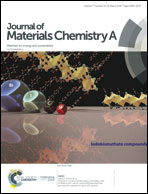Construction of unique heterogeneous cobalt–manganese oxide porous microspheres for the assembly of long-cycle and high-rate lithium ion battery anodes†
Abstract
Porous (Co, Mn)(Co, Mn)2O4-based microspheres (CM-11-Ms) and core–shell microspheres (CM-11-CSMs) were firstly synthesized via controlled pyrolysis of CoMn-precursor microspheres at different temperatures under nitrogen. During pyrolysis of the CoMn-precursor, the carbon derived from hexamethylenetetramine and polyethylene glycol transforms part of (Co, Mn)(Co, Mn)2O4 into MnO and Co3O4. As an anode for lithium ion batteries, CM-11-Ms exhibits a specific capacity of 745 mA h g−1 after 650 cycles at 1 A g−1, while CM-11-CSMs exhibits an enhanced lithium storage capacity of 2175.8 mA h g−1 even after 1000 cycles at 1 A g−1 without an evident capacity decay. The improved electrochemical properties could be attributed to the unique core–shell structure that accommodates the volume expansion during cycling, the high-rate lithiation-induced reactivation, and the synergy effects among (Co, Mn)(Co, Mn)2O4, Co3O4, and MnO.

- This article is part of the themed collection: 2019 Journal of Materials Chemistry A Most Popular Articles


 Please wait while we load your content...
Please wait while we load your content...